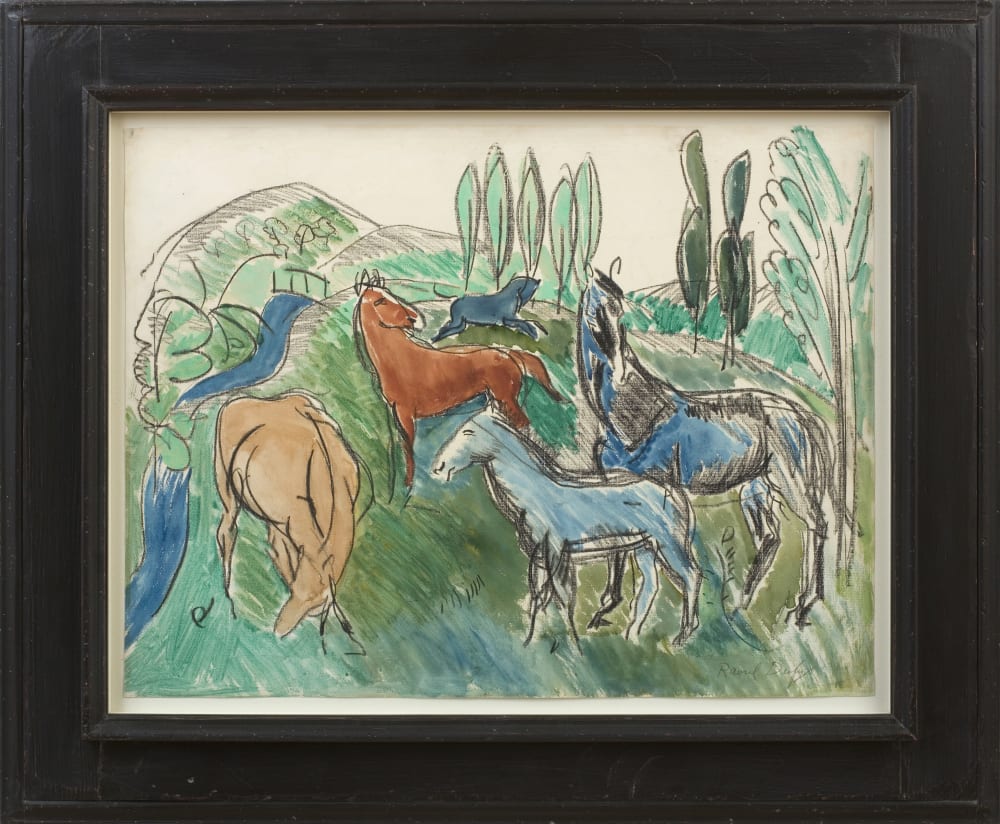Raoul Dufy
Dans les prairies de l'Eure, 1919, c.
Watercolour, crayon and charcoal on paper
43 x 57 cm
16 7/8 x 22 1/2 in
16 7/8 x 22 1/2 in
The department of l’Eure lies to the northwest of Paris and could be reached from Raoul Dufy’s studio in the 18e arrondissement in just over an hour by train. Dufy was born in Le Havre, to the north of l’Eure on the Channel coast, and throughout his life he returned to his native Normandy to make pictures there. The ‘prairies’ or grass planes depicted in this work were presumably of less interest to Dufy than the group of five horses, which were a subject of special interest to him throughout his life. Over the course of his career, he depicted plough horses in the wheat fields, hunting horses in the Bois de Boulogne, and racehorses in the paddocks of Epsom, Ascot and Deauville.
Dufy was at first a follower of trends, and his early works show a wholesale adoption of fauvism and cubism. Around 1920, however, he began developing a distinctive personal manner based on the creation of pictorial space using harmonised areas of chromatic colour. An early suggestion of this approach is apparent in Dans les prairies de l’Eure, where the streaked, shimmering bodies of two horses at the lower right of the picture are fluidly integrated with the grassland and the surrounding trees. Though some critics questioned the modernity of his work, feeling its beauty to be uncritical and nostalgic, Dufy himself was unconcerned by this charge, commenting: ‘Whether the pleasure he has gained for himself be shared or not, whether his work be in concord or contradiction with the tastes of the times, whether it be ahead or behindhand, the artist is neither able to do anything about it nor concerned to try.’
In any case, since his death in 1953, Dufy has enjoyed critical support from many of his artistic peers. In 1959, Igor Stravinsky dedicated a double canon to ‘Raoul Dufy in memoriam’; other figures in the composer’s cycle of atonal tombeaux included Dylan Thomas, T.S. Eliot and J.F. Kennedy. In a poem of December 1972, ‘As Dufy Paints’, the Francophile English poet Geoffrey Grigson wrote these words:
[...] as Raoul Dufy paints,
To write like the bright sap green
Which lights dry saddening banks
Beside charcoal of hard roads in the spring
(Adding rose madder and a deep sky blue)
For all of us is good; and is for the sadder
Writers, a most enviable thing
Later, a retrospective of Dufy in London was described by the painter Peter de Francia as ‘revelatory and timely’. The wide spectrum of Dufy’s critical support suggests the lasting importance of his work, of which Dans les prairies de l’Eure is a fluent and freely executed example.
Provenance
Berthe Reysz, acquired directly from the artistThe Estate of Berthe Reysz
At Sotheby Parke Bernet & Co., London, 31 March 1982, lot 257
Private Collection
Exhibitions
2020, London, Piano Nobile, Drawn to Paper: Degas to Rego, 24 June - 24 July 2020, cat. no. 6Literature
Fanny Guillon-Laffaille, Raoul Dufy: Catalogue raisonné des aquarelles, gouaches et pastels, Carré, 1981, cat. no. 632 (illus.) (listed as 'Chevaux dans la campagne')Drawn to Paper: Degas to Rego, exh. cat., Piano Nobile, 2020, pp. 16-17
The authenticity of this work has been confirmed by Mme. Fanny Guillon-Laffaille.

